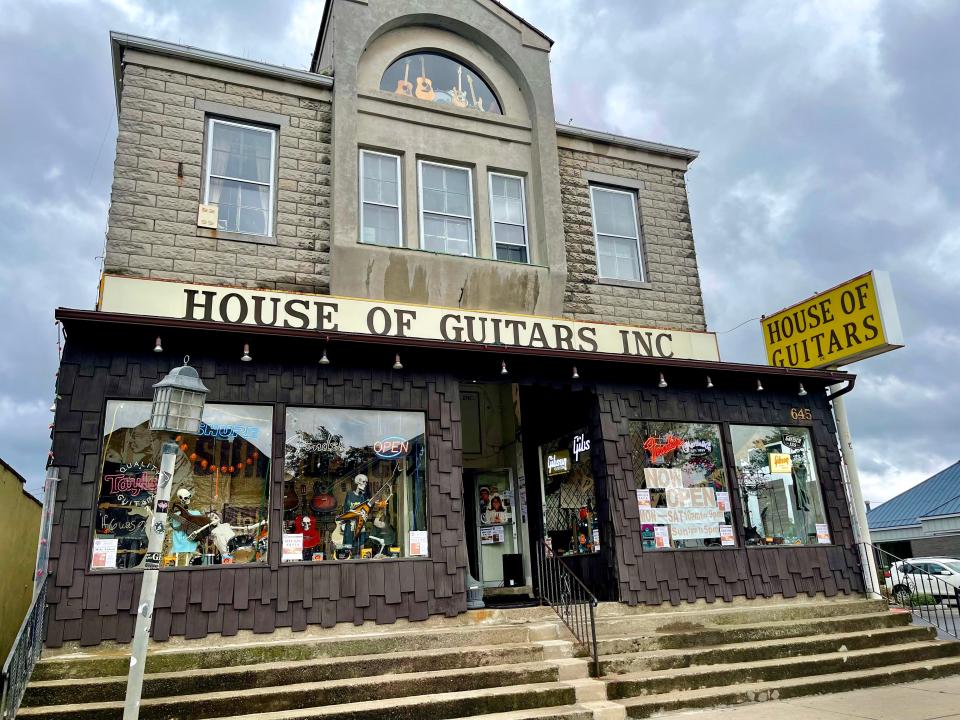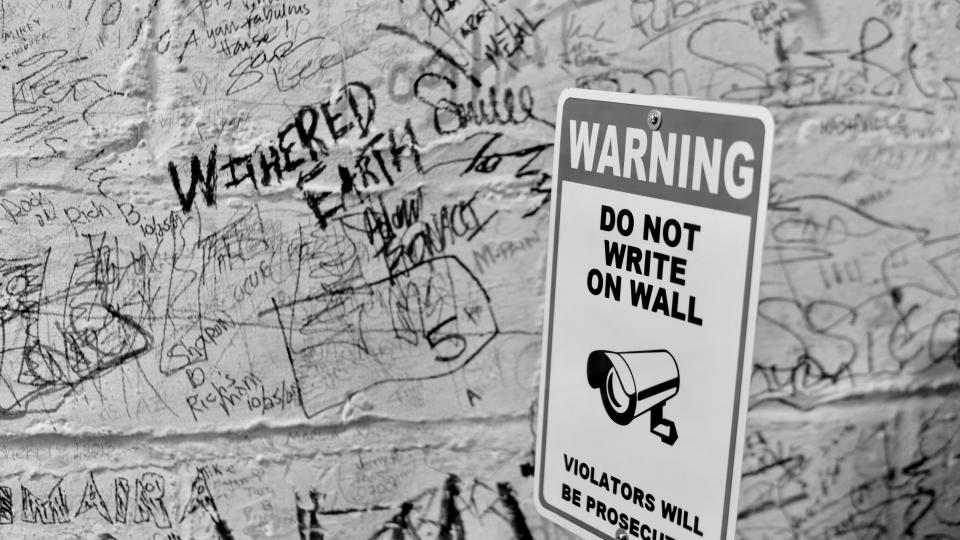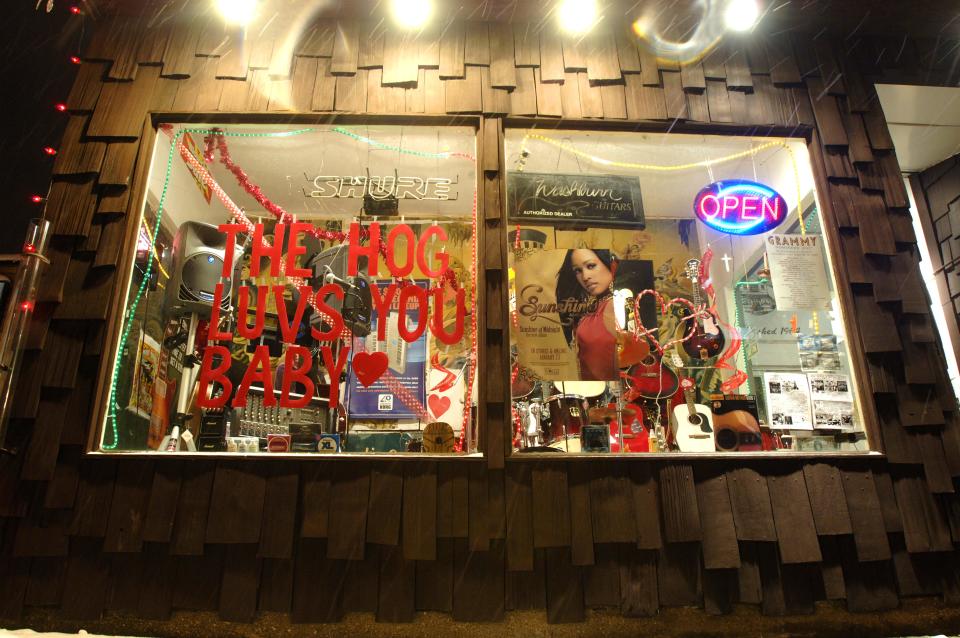Music stars go out of their way to gawk at stuff inside this New York store
The House of Guitars. Where do you even begin?
If it’s 1983 and you’re Metallica, with the T-shirts.
In town for two weeks in May of that year to record their debut album, Kill ’Em All, at a studio in Rochester’s East End, members of the then-unknown California metal band wandered into the legendary music shop while their clothes were going through the spin cycle at a laundromat down the street.
Looking to lighten their load, they asked the store to comp them T-shirts.
“You could see they were kind of running without money in their pocket,” said Bruce Schaubroeck, who with older brother Armand founded the HOG in Irondequoit in 1964.

Armand couldn’t recall giving the band — whose lineup at the time was James Hetfield, Lars Ulrich, Kirk Hammett and Cliff Burton — store-branded merchandise, but he and Bruce definitely provided sustenance.
“If we had doughnuts in the morning, they had doughnuts,” Bruce said. “If we had coffee, they had coffee.”
They also encouraged the struggling musicians to try out any of the tens of thousands of instruments in stock at 645 Titus Ave.
“They said, ‘No, man, I don’t wanna waste your time. I don’t have no money’,” Armand recalled.
But, said Bruce, “They got comfortable after a while.”
“Yeah, they started playing stuff,” Armand said.
Flash forward a decade, and Metallica, having ascended to rock superstardom, was headlining a show at Darien Lake. They called to ask whether the HOG could stay open late for some post-concert shopping and promised to supply the beer.
After midnight, they arrived bearing cases of a premium Japanese import. “The limo driver kept bringing it in,” Bruce said.
When all was said and done, “They spent over $70,000 on vintage guitars,” Armand said.
It is the sort of rags to riches story the Schaubroeck brothers are familiar with, having lived it themselves by turning a few thousand bucks saved from working odd jobs into a one-of-a-kind retail destination that has endured for 57 years, is known worldwide and brings in gross annual revenues of $4 million.
Underground operation

Armand Schaubroeck Sr. and his wife, Doris, bought their home in Irondequoit in the early 1940s and started a family a couple years later.
Despite the tidy suburban locale, life was less than idyllic.
“We came up pretty poor, an impoverished family,” Bruce said.
And one that routinely operated under other forms of immense pressure.
Armand Sr. suffered from severe post-traumatic stress disorder brought on by his service as a Marine in World War II’s Guadalcanal campaign. For most of his children's lives, he was confined to the VA hospital in Canandaigua.
Kids were not allowed in the facility, but Armand and Bruce, younger brother Blaine and little sister Beryl would meet up with their dad in the parking lot when he was feeling up to it.
He’d be discharged and reunite with the family for stretches but always relapse, Armand said, walking around the house at night making crow noises (which is how Marines tracked each other in the jungle) and stalking imaginary Japanese troops.
“He was almost sleepwalking,” Armand said.
So, Doris wound up doing double duty as single mom and factory laborer, including at Shuron Optical, an eyeglass manufacturer on Andrews Street in downtown Rochester.
At work, "She was treated bad by men saying she shouldn’t be taking a man’s job, and women should stay home and be in the kitchen," Armand said.
And at home, as a mother of four, her plate was full.
Asked to describe himself and his siblings during those years, Armand said, "I thought we were pretty mature, but we were kids."
At 17, though, he was sent to a correctional facility in Elmira for his role in a string of burglaries. He was paroled a year and half later and began working at a meat market in the city. He said he learned a lot from the experience. “I wasn’t in the union, so I could work all over the place.”
Bruce delivered newspapers and mowed lawns.
Both had bigger plans, and income from their humble endeavors was seed money for the House of Guitars, originally located in the family's basement.
'Totally different' approach
Armand was 20 and Bruce was still in high school when they launched the business, which coincided with the Beatles' hysteria-inducing first world tour, "when the guitar craze was full-blown," Armand said.
At that time, most local music stores were downtown. “And they may only have had four or five guitars in the whole music store,” he said. “And if you were a young person coming in, they would tell you to come back with your parents. They really wouldn’t wait on you.” And they definitely didn’t want you handling their guitars.
But from the beginning, the House of Guitars offered a wide range of models and encouraged their young customers to play them. The HOG also was the first North American retailer to sell Vox amplifiers, the brand the Beatles used.
“We were kids selling to kids,” Armand said, gesturing to Bruce. “We’d have kids all over the basement playing guitars without their parents, just blasting away. So, our approach was totally different. The kids, they knew more about it than the parents. They knew what was good and what wasn’t.”
“Still do,” said Bruce with a laugh.
Like their customers, the brothers played in bands, and they were willing to engage in haggling and discount merchandise to make sales.
"Something that might be selling for $300 downtown, we might let it go for $195," Armand said.
Fond of vintage instruments, they accepted trade-ins, which their competitors did not.
The business was taking off, but the chaotic scene that had become its trademark was taking a toll on their mother. One day after arriving home utterly drained from her factory job, she threw everyone out.
Making some moves

So, the HOG moved to Rochester — first Clinton Avenue and then Norton Street.
A subsequent location at Lake Avenue and Stutson Street had an adjoining building where the Schaubroecks ran an all-night coffeehouse called The Black Candle. Its stage hosted some impressive talent, including legendary bluesman Son House, but it was short-lived.
The place didn't have a liquor license. "It was hard to make money selling hot cherry cider with cinnamon sticks,” Armand explained.
At times, it was hard to make money, period, and whatever the operation took in during those initial years was reinvested.

“In the early days, we wouldn’t spend something on ourselves at all,” Armand said. “We were lucky if we bought a cup of coffee and a hamburger, really.”
But, “We were content and happy and felt free. We enjoyed the struggle.”
The HOG found its way to Jefferson Road in Henrietta before returning to a Titus Avenue storefront. Armand and Bruce bought 645 Titus, the former Irondequoit Grange Hall, in 1972.
The town’s zoning board actually refused to grant the business a special-use permit needed to operate. But that decision was overturned in state Supreme Court, paving the way for the structure, built in 1910 by farmers as an agricultural center and gathering place, to be “filled with guitar music,” the Democrat and Chronicle reported at the time.
Actually, by 1960, guitar music already was bouncing off the walls. That year, a local surf-rock group called The Tempests played a show at the Grange and recorded the single “Rockin’ Rochester USA,” featuring the lyrics, Well, I gotta pretty girl a-waitin’ there for me / She’s gonna give me kisses down by the Genesee.
In the audience listening was teenage Armand.
Welcome to the jumble

Taking over the Grange helped cement the store as iconic, but right from the start, space was tight. That original building, which now mostly holds guitars (the majority for sale and a few for show, like the ones autographed by Eddie Van Halen, Chet Atkins, B.B. King and other luminaries) was “filled to capacity because all the albums and tapes were up there, too,” Armand said.
Over time, a series of additions extending off the back created the HOG’s distinctive maze-like, multilevel layout, with areas dedicated to keyboards, drums, other instruments and amps; the House of Guitars School of Music; an instrument repair shop, Robinson Kustom Shop; and an expansive back room, which holds millions of CDs, DVDs, LPs, tapes, T-shirts and more.
The sheer volume of stuff creates the impression of disorganization and plays to the retailer's tagline, "The Store That Ate My Brain."
Armand insists that the majority of music releases are categorized and alphabetized. However, “We can’t fit everything in the racks, so we have lots of boxes.” Yes, lots.
Alongside the items for sale are enough rock ’n’ roll and pop-culture artifacts to fill a decent-sized museum.
Every available surface, including the ceiling, is covered, and among the mementos are a few true oddities. Like a striped pair of Jimi Hendrix’s pants.
According to Armand, the legendary guitarist left them at a party thrown by the Moody Blues during the 1960s. It isn’t clear what he wore home. The HOG got the pants from former band member Denny Laine in an exchange for a combination of equipment and money.
The store also acquired a pair of Elvis Presley’s pants from Laine. The King never wore them in concert — “He only wore them when he rode his motorcycle around Graceland,” Armand said. Laine got the pants from Paul McCartney after joining his band, Wings. At some point prior to that, they had become the property of the Beatles.
Speaking of which, displayed between those two garments is a jacket once owned by John Lennon that looks like something he could have worn on the cover of the Sgt. Pepper’s album but didn’t.
The HOG also owns a limited-edition painting of Frank Sinatra by Tony Bennett, any number of autographed platinum albums (including by Bruce Springsteen and Janet Jackson), scores of autographed photos of everyone who is or was anyone in the music business (including Michael Jackson), and wait, is that a picture of Eddie Munster? Yes, signed by Butch Patrick, the actor who played the young werewolf on the 1960s-era sitcom The Munsters. It hangs directly above a shot of Armand standing beside Marvel Comics legend Stan Lee when he visited.
It is hard to know where to look.
Wall of fame and famous shoppers

But in case you somehow missed it, allow us to direct your attention to the wall at the front of the back room, signed by thousands of musicians, many of them household names.
The white expanse is completely covered with autographs. Some — including by Aerosmith — are so old they’ve nearly faded away. Others are easy to spot: Marilyn Manson, Megadeth, Lita Ford, Les Paul, “Weird Al” Yankovich and Nancy Sinatra. She also signed an album she made in 1968 with Lee Hazelwood, her collaborator who wrote “These Boots Are Made for Walkin’.”
Many of those same folks have been, and continue to be, HOG customers. Besides Metallica, Ozzy Osbourne — who did an in-store meet-and-greet on the same day as Mötley Crüe — Peter Gabriel, Geddy Lee, Dickie Betts and REO Speedwagon have shopped there.
“REO comes in all the time,” Bruce said. “Every time they’re in town.”
Manson bought a Rickenbacker guitar at the HOG and later was pictured with it on the cover of Guitar Player magazine.
In June 2013, Sheryl Crow stopped in — and she walked out with a Fender Buck Owens Telecaster with a red, white and blue sparkle finish.

She was on her way to a concert in Buffalo when she diverted her tour bus, Bruce recalled. “She says, ‘I heard a lot about this store, and I wanted to come in and take a look.’ And she walks in the door and she goes, ‘Oh. My. God.’”
While surveying the scene, she began rattling off the years, makes and models of all the guitars on display.
“That would be hard for some of my employees to do,” Bruce said. “So, we had all the guys on ladders pulling everything down.”
At one point, her road manager got antsy, telling her, "Sheryl, we gotta get going. We got a soundcheck.”
She wasn’t having it.
“She said, ‘Go in the truck,’” Bruce said with a laugh.
Crow used that Telecaster at her Buffalo show and a few months later on a Country Music Association special.
She could not have bought Bruce's favorite guitar in the store, a 1947 John D'Angelico New Yorker model, even if she wanted to. "I wouldn’t sell it," he said. "I think at one time we were offered, like, $100,000. I said no. I mean, that stuff’s cooler than money. You’re not gonna replace it."

The same goes for a reel-to-reel tape machine on which Garth Brooks recorded many of his hits. The HOG got it from the country superstar for equipment and cash and has held onto it, despite being offered "crazy money" by Nashville's Country Music Hall of Fame, Bruce said.
Sound advice
After appearing at the HOG and shopping there, shock rocker Manson called with a question about how to create a certain sound for an album.
Many other big-name musicians have turned to the store for such expertise, including Nine Inch Nails front man Trent Reznor.
“He would call quite a bit when he had a recording studio, you know, out west. He would call looking for different effects,” Armand said.
The shop, by the way, has its own basement recording studio (which is where Brooks' old tape machine resides) and record label, Mirror Records, which has put out releases by the Chesterfield Kings, Dirty Looks, Bat McGrath, Don Potter and Armand himself.
“It might take a few days to analyze what they’re talking about,” Bruce said of the inquiries, but they've always been able to figure out the corresponding pieces of equipment, which usually are antique. In Manson’s case a vintage pedal was needed.
But do they have those items in stock?
“Somewhere, if we can find it,” Armand said, glancing around.
Back in the saddle
Things may get misplaced from time to time, but that packed-to-the-rafters atmosphere is part of the HOG’s identity, and it has a certain allure.
It did for Aerosmith. During the mid-1980s, while staging a comeback after a period of turmoil, the band used the store as a backdrop for a Rolling Stone magazine photo shoot.
“They’d been here before when they were kids, when they first started,” Armand said, and were searching for a setting with a lot of guitars.
“At first they wanted us to close the store,” he said. “We said, ‘We won’t. We can’t do that.’ So, they said, ‘Well, don’t tell everybody.’”
They didn’t, and the shoot went off without garnering publicity, even though it stretched over several days and the photographers who had flown in from Boston and New York City “were laying tracks all over to slide the lights and everything, so everybody knew something was up,” Armand said.
Also aiding in Aerosmith’s rebirth was a “Walk This Way” remake with rap act Run-DMC, which once did a scratch clinic with Whodini’s master DJ on the store's front stage. (In recent years, the HOG has hosted shows on an outdoor stage at the adjacent I-Square development.)
Ron Isley, founder of legendary R&B group The Isley Brothers, made an appearance at the store. “He looked all dapper in a bright red sport jacket,” Armand recalled.
Jon Bon Jovi has visited multiple times and on one occasion made the mistake of kissing a female fan who had waited in line to meet him, Bruce said. “Then he had to kiss all of them.”
Jukebox and local hero Lou Gramm has met admirers at the House of Guitars and performed there. In June, he presided over a raffle that raised more than $13,000 for Camp Good Days. Hip-hop artist Tyler the Creator stopped in before a 2018 show at the Main Street Armory. And in a poignant scene, McGrath, a longtime friend of the store, signed CDs there prior to an April 2019 Lovin’ Cup show, the last one he played here before succumbing to colon cancer.
'They could see my lack of talent'

The brothers may have succeeded in keeping a lid on that Aerosmith shoot, but there is no doubt they're masters at attracting attention to their business.
The HOG's low-fidelity late-night TV commercials, featuring dizzying, sometimes out-of-focus camera work and Armand in rabbit ears, have "brought tons of people" into the store, he said. The spots even inspired fan mail and hate mail, which the HOG spun into publicity by holding a Best Fan Mail/Best Hate Mail contest.
It's just one of countless examples of the Schaubroecks' knack for engaging the masses in novel ways.
In 1988, the House of Guitars made the Guinness Book of World Records for loudest band, breaking a record set in 1976 by The Who. Armand, Blaine — who worked at the store over the years before retiring — and the members of local rock band Immaculate Mary (also employees) plugged in every last one of the HOG's Marshall amplifiers for a performance of "Fading Out," written by Armand during the 1960s, at 123 decibels at 50 meters (around 164 feet).
Besides Guinness, the stunt caught the attention of Marshall founder Jim Marshall, aka The Lord of Loud, who thanked the store by gifting it a Marshall full stack, the company's largest, most powerful amp.
During the early 1990s, the store's World’s Worst Guitarist competitions drew thousands of entries (on cassette tapes) from around the globe, drawing international publicity.
In 1991, a guy from Scotland prevailed by butchering that rock star-wannabe staple, “Smoke on the Water,” by Deep Purple. Chicago-area resident Nick Svalina relished his '92 victory, telling reporters, "They could see my lack of talent."
Within the space of two months in 1997, the HOG was featured in The Wall Street Journal and People magazine. In 2002, Details magazine named it a top guitar shop, and in 2003, it was listed as the No. 2 stop on Esquire magazine's "Roadmap to Musical America."
Harmonious arrangement

While capitalizing on the strange appeal of uniquely ungifted musicians, since its early days, the House of Guitars has made a habit of hiring fine and accomplished ones. In fact, most of the retailer's employees are musicians and have included Andy Babiuk of the Chesterfield Kings and Dennis Casey of Flogging Molly.
Irondequoit native Casey, currently on tour with the Celtic punk outfit, called his time there "one of my favorite jobs I've ever had."
He was employed at the store during the late 1980s. "I was working in the back, right when CDs first came out," he told the Democrat and Chronicle in 2002. "People were always coming up asking, 'Is Dark Side of the Moon out on CD yet?' But the best part was when Julio Iglesias tickets would go on sale, we'd blast the Dead Kennedys real loud while people were standing in line."
Being imaginative guys themselves, Armand and Bruce understand creative personalities. But above all, they are businessmen, and it's always made good business sense to hire musicians or people who have studied music or have music-industry aspirations.
"You’ve gotta know what you’re talking about," Bruce said.
"And it ain’t painful for them," Armand said. "They’re close to what they want to be, even if they won't want to work at the House of Guitars for the rest of their lives." On the payroll now, for instance, are twin brothers Michael and Eric Pinales, who both have recording degrees.
"We've got another guy who was a trombone major," Bruce said.
Looking ahead

Armand turned 77 in January, and Bruce will hit 74 this month, although they appear far younger.
Armand, who in 1968 famously put up billboards around town reading, "Help Keep American Free: Let Your Hair Grow," still wears his with a kind of studied unruliness. Bruce said he doesn't feel like someone well into his seventh decade, in part because his job doesn't drag him down — just the opposite. "I like coming in to work," he said, and does so side by side with other family members, including sister Beryl, a career educator who for many years taught at DeSales High School in Geneva.
Armand and his wife, Linda, have four children, two of whom work at the HOG — Armand II and Aric. Bruce and his longtime partner, Cindy, have five, and their son Michael is an employee.
Neither brother shows signs of slowing down, and the two have no plans to retire, but at some point they expect the business will pass to their kids.
Armand isn't exactly sure what that will look like. There have been no formal succession-plan talks (the retailer's principals don't really have job titles or offices either), but he has faith in his sons and nephew.
"They all work here full time, all of them, and they're doing important things in the business," he said. "They're a lot better around computers than we are, anyway. They’re sharp."
Said Aric, 35, who has worked at the store in various roles since he was a teenager, "I wouldn’t want to change a good thing, that’s for sure. We're here for the community and Rochester. My brother, Armand, and my cousin, we’ve all worked here a long long time, and we love what we do."
So, the House of Guitars will endure. And after being hurt by — but surviving — the coronavirus pandemic, is expecting robust holiday sales. It's why, COVID or no COVID, Bruce never let up on bringing in new merchandise.
"Christmas is Christmas, and people will find a way to buy," he said.
Replied Armand, "Either that, or the world’s gonna die."
Reporter Marcia Greenwood covers general assignments. Send story tips to mgreenwo@rocheste.gannett.com. Follow her on Twitter @MarciaGreenwood.
This article originally appeared on Rochester Democrat and Chronicle: House of Guitars: Stories you haven't heard by the men who built it

